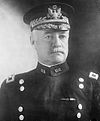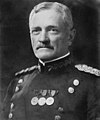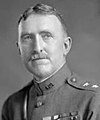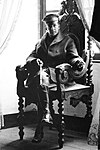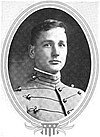
The United States Military Academy (USMA), also known metonymically as West Point or simply as Army, is a United States service academy in West Point, New York. It was originally established as a fort, since it sits on strategic high ground overlooking the Hudson River 50 miles (80 km) north of New York City. It is the oldest of the five American service academies and educates cadets for commissioning into the United States Army.

George Catlett Marshall Jr. was an American army officer and statesman. He rose through the United States Army to become Chief of Staff of the U.S. Army under Presidents Franklin D. Roosevelt and Harry S. Truman, then served as Secretary of State and Secretary of Defense under Truman. Winston Churchill lauded Marshall as the "organizer of victory" for his leadership of the Allied victory in World War II. After the war, he spent a frustrating year trying and failing to avoid the impending Chinese Civil War. As Secretary of State, Marshall advocated for a U.S. economic and political commitment to post-war European recovery, including the Marshall Plan that bore his name. In recognition of this work, he was awarded the Nobel Peace Prize in 1953, the only Army general ever to be so honored.

Lucius Roy Holbrook was a major general who commanded the United States Army's Philippine Department from 1936 to 1938.
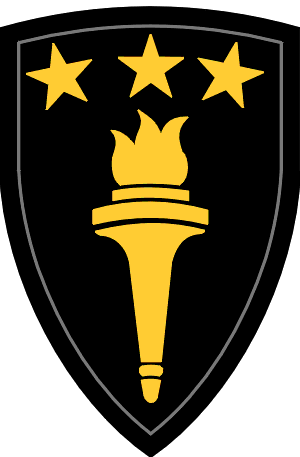
The United States Army War College (USAWC) is a U.S. Army educational institution in Carlisle, Pennsylvania, on the 500-acre (2 km2) campus of the historic Carlisle Barracks. It provides graduate-level instruction to senior military officers and civilians to prepare them for senior leadership assignments and responsibilities. Each year, a number of Army colonels and lieutenant colonels are considered by a board for admission. Approximately 800 students attend at any one time, half in a two-year-long distance learning program, and the other half in an on-campus, full-time resident program lasting ten months. Upon completion, the college grants its graduates a master's degree in Strategic Studies.
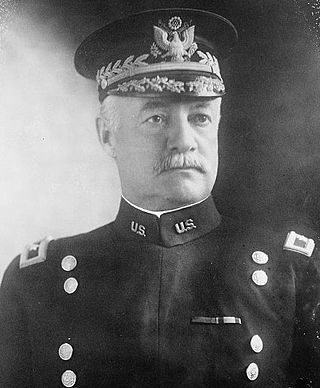
Lieutenant General Hunter Liggett was a senior United States Army officer. His 42 years of military service spanned the period from the Indian campaigns to the trench warfare of World War I. Additionally, he also identified possible invasion sites in Luzon, particularly Lingayen Gulf, which were used during World War II in 1941 by the Japanese and in 1945 by the United States.

The M46 Patton is an American medium tank designed to replace the M26 Pershing and M4 Sherman. It was one of the U.S Army's principal medium tanks of the early Cold War, with models in service from 1949 until the mid-1950s. It was not widely used by U.S. Cold War allies, being exported only to Belgium, and only in small numbers to train crews on the upcoming M47 Patton.

Fox Conner was a major general of the United States Army. He served as operations officer for the American Expeditionary Forces (AEF) during World War I, and is best remembered as a mentor to the generation of officers who led the army in World War II, particularly as "the man who made Eisenhower".
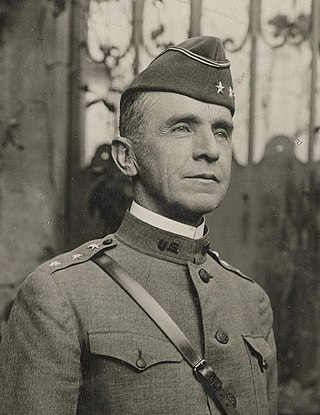
Lieutenant General Robert Lee Bullard was a senior officer of the United States Army. He was involved in conflicts in the American Western Frontier, the Philippines, and World War I, where he commanded the 1st Infantry Division during the Battle of Cantigny while serving on the Western Front. He later was an administrator in Cuba.

Major General Clarence Ransom Edwards was a senior United States Army officer, known as the first Chief of the Bureau of Insular Affairs, and commander of the 26th Division in World War I.

Garrison Holt Davidson was a United States Army officer, combat engineer, commander, and military educator from the 1920s through World War II and into the Cold War-era. Commissioned as one of the youngest generals during World War II, he achieved the rank of lieutenant general before his mandatory retirement from the army in 1964. Davidson served as the Superintendent of the United States Military Academy from 1956 to 1960. He also played and coached football at West Point, helming the cadet squad as head coach from 1933 to 1937, compiling a record of 35–11–1.

Lieutenant General Stafford LeRoy Irwin was a senior United States Army officer who served in World War II. He came from a family with a strong military tradition: he was the son of Major General George LeRoy Irwin -- for whom Fort Irwin, California, is named -- while his grandfather, Brigadier General Bernard J. D. Irwin, was a recipient of the Medal of Honor.

General of the Armies John Joseph Pershing, nicknamed "Black Jack", was a senior United States Army officer. He served most famously as the commander of the American Expeditionary Forces (AEF) during World War I from 1917 to 1920. In addition to leading the AEF to victory in World War I, Pershing notably served as a mentor to many in the generation of generals who led the United States Army during World War II, including George C. Marshall, Dwight D. Eisenhower, Omar Bradley, Lesley J. McNair, George S. Patton and Douglas MacArthur.

John Wilson Ruckman was a major general in the United States Army.

Pershing House has been the residence of the commanding officers of Fort Sam Houston since 1881. Located in Bexar County, San Antonio, Texas, the military post is currently part of Joint Base San Antonio. The house was added to the National Register of Historic Places listings on 30 July 1974. After the Texas annexation to the Union in 1845, the United States Army became a steady presence in what was then designated the Department of Texas, providing a line of defense during both the 1846–1848 Mexican–American War, and the Texas–Indian wars that ended with the 1875 surrender of Comanche chief Quanah Parker at Fort Sill, Oklahoma. The combining of Fort Sam Houston, Randolph Air Force Base, Lackland Air Force Base and Martindale Army Airfield, to create Joint Base San Antonio, took place in 2009.

Major General James Garesche Ord was a United States Army officer who briefly commanded the 28th Infantry Division and was Chairman of the Joint Brazil–U.S. Defense Commission during World War II.


